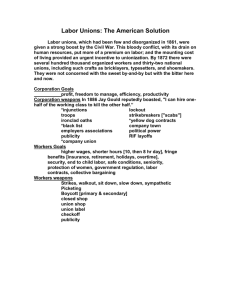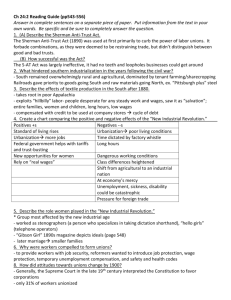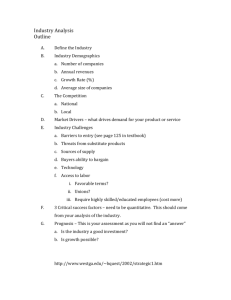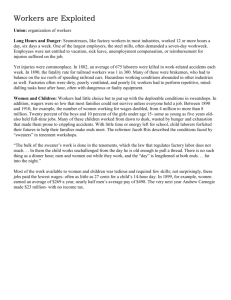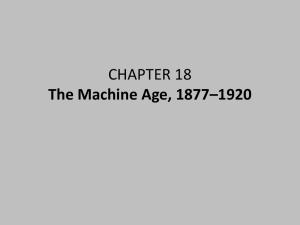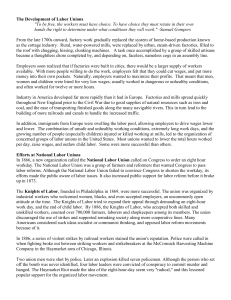Notes CH 24 Part 2 The South in the Age of Industry *****The South
advertisement
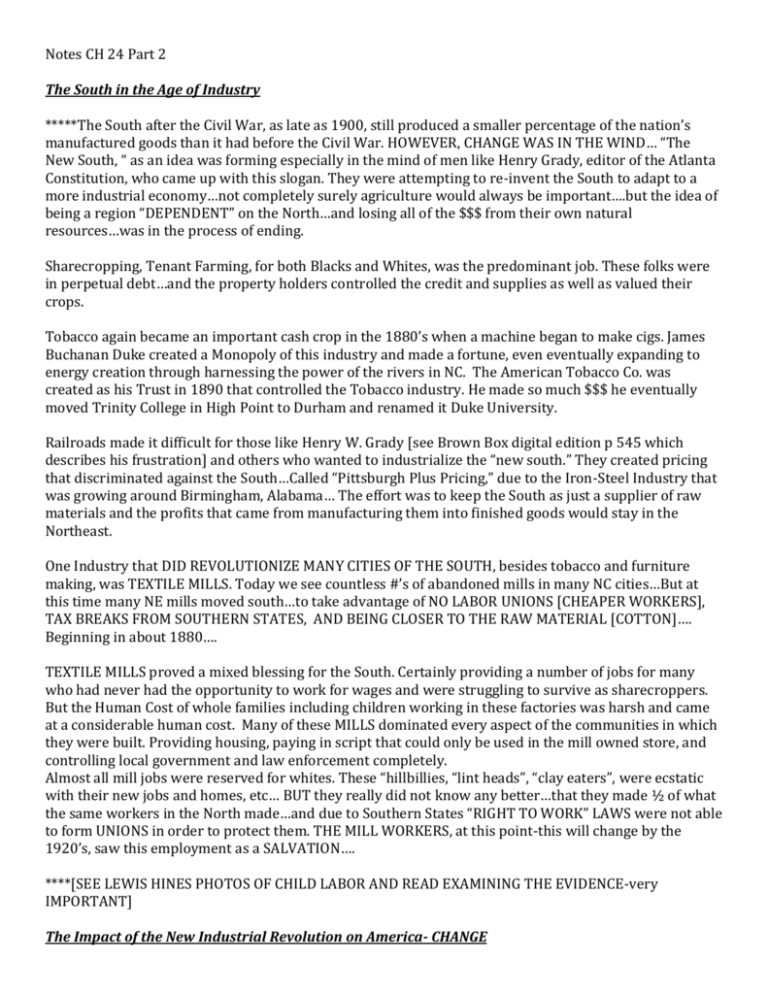
Notes CH 24 Part 2
The South in the Age of Industry
*****The South after the Civil War, as late as 1900, still produced a smaller percentage of the nation’s
manufactured goods than it had before the Civil War. HOWEVER, CHANGE WAS IN THE WIND… “The
New South, “ as an idea was forming especially in the mind of men like Henry Grady, editor of the Atlanta
Constitution, who came up with this slogan. They were attempting to re-invent the South to adapt to a
more industrial economy…not completely surely agriculture would always be important….but the idea of
being a region “DEPENDENT” on the North…and losing all of the $$$ from their own natural
resources…was in the process of ending.
Sharecropping, Tenant Farming, for both Blacks and Whites, was the predominant job. These folks were
in perpetual debt…and the property holders controlled the credit and supplies as well as valued their
crops.
Tobacco again became an important cash crop in the 1880’s when a machine began to make cigs. James
Buchanan Duke created a Monopoly of this industry and made a fortune, even eventually expanding to
energy creation through harnessing the power of the rivers in NC. The American Tobacco Co. was
created as his Trust in 1890 that controlled the Tobacco industry. He made so much $$$ he eventually
moved Trinity College in High Point to Durham and renamed it Duke University.
Railroads made it difficult for those like Henry W. Grady [see Brown Box digital edition p 545 which
describes his frustration] and others who wanted to industrialize the “new south.” They created pricing
that discriminated against the South…Called “Pittsburgh Plus Pricing,” due to the Iron-Steel Industry that
was growing around Birmingham, Alabama… The effort was to keep the South as just a supplier of raw
materials and the profits that came from manufacturing them into finished goods would stay in the
Northeast.
One Industry that DID REVOLUTIONIZE MANY CITIES OF THE SOUTH, besides tobacco and furniture
making, was TEXTILE MILLS. Today we see countless #’s of abandoned mills in many NC cities…But at
this time many NE mills moved south…to take advantage of NO LABOR UNIONS [CHEAPER WORKERS],
TAX BREAKS FROM SOUTHERN STATES, AND BEING CLOSER TO THE RAW MATERIAL [COTTON]….
Beginning in about 1880….
TEXTILE MILLS proved a mixed blessing for the South. Certainly providing a number of jobs for many
who had never had the opportunity to work for wages and were struggling to survive as sharecroppers.
But the Human Cost of whole families including children working in these factories was harsh and came
at a considerable human cost. Many of these MILLS dominated every aspect of the communities in which
they were built. Providing housing, paying in script that could only be used in the mill owned store, and
controlling local government and law enforcement completely.
Almost all mill jobs were reserved for whites. These “hillbillies, “lint heads”, “clay eaters”, were ecstatic
with their new jobs and homes, etc… BUT they really did not know any better…that they made ½ of what
the same workers in the North made…and due to Southern States “RIGHT TO WORK” LAWS were not able
to form UNIONS in order to protect them. THE MILL WORKERS, at this point-this will change by the
1920’s, saw this employment as a SALVATION….
****[SEE LEWIS HINES PHOTOS OF CHILD LABOR AND READ EXAMINING THE EVIDENCE-very
IMPORTANT]
The Impact of the New Industrial Revolution on America- CHANGE
According to the text, the impact of the 2nd industrial revolution on people was tremendous…standard of
living rose, workers were well fed and enjoyed more physical comforts than those that lived in ANY
OTHER INDUSTRIAL NATION, and there were abundant JOBS in the mushrooming CITIES that held
countless new FACTORIES… Why then were so many workers upset?
Agriculture was declining in relation to manufacturing…Jefferson’s dream of a nation of small farmers
practicing free enterprise without the restraints of govt interference was floating away as smoke
billowed from the factories into the sky….
The Federal Govt’s influence on the nation was increasing, it began during the massive Civil War, and
with the Federal Govt’s army in the WEST fighting Native Americans, dictating Mining and Resource
Mgmt, subsidizing RR’s, beginning to “regulate” [ICA and SATA] businesses, and passing high protective
tariff’s….Hamilton’s dream of a “mixed” economy of manufacturing, agriculture, and powerful Federal
Govt control over Banking and Tariff’s was becoming a REALITY.
OTHER CHANGES:
Time – most people in America, up to this point, were used to living their lives by nature’s clock….now
were living their lives to the Factory whistle…and electric light. RR’S CREATED 4 STANDARD TIME
ZONES. Factory, assembly line, efficiency was demanded and this discipline did not come naturally to
humans…they were not machines.
Women – “PROBABLY NO SINGLE GROUP WAS MORE PROFOUNDLY AFFECTED BY THE NEW
INDUSTRIAL AGE THAN WOMEN.” Two inventions, the typewriter and telephone switchboard, thrust
women into industrial jobs…millions of stenographers and “hello girls” discovered new economic and
social opportunities…THE “GIBSON GIRL” [SEE ADVERTISING IN TEXT] was the image presented as the
‘NEW ATHLETIC INDEPENDENT WOMAN,” in MAGAZINES in the 1890’s. This, for middle-class women
often meant delayed marriages and smaller families…MOST WOMEN, HOWEVER, DID NOT WORK FOR
CHOICE BUT ECONOMIC NECESSITY !!! …these lower class women worked long hot hours in difficult
working conditions in factories and earned less $$$ for doing the same exact work as boys or men.
Class division – while the upper classes were flaunting their enormous wealth….this was resented by
others who did not fare as well….and new political philosophies from Europe such as SOCIALISM,
Communism, and ANARCHISM came to our shores with the influx of immigrants….to some in the working
class these philosophies were appealing and mixed with our democratic traditions…and due to the
seeming growing PLUTOCRACY OR OLIGARCHY OF $$$ CONTROLLING OUR GOVT AND DAILY
LIVES…our democratic traditions allowed for the working class to express themselves at the polls in an
attempt to change this situation, ex: rise of smaller 3rd parties for farmers, unionists, and workers.
THIS FACT: 10% OF THE PEOPLE CONTROLLED 90% OF THE WEALTH – INCOME
GAP*****FESTERED THESE RADICAL IDEAS TO CHANGE THE PLUTOCRACY OF WEALTH IN
AMERICA.
-IN 1860 50% OF AMERICANS WERE SELF-EMPLOYED
-BY 1900 66% OF AMERICANS WERE WAGE EARNERS…
A DRAMATIC SHIFT.
This new dependence on wages put an enormous # of people in a precarious position as the 19th century
continued…as the two depressions, 1873 & 1893 illustrate…each impacted a larger # of people, people
that were now dependent on this industrial economy to survive…especially because THERE WAS NO
SAFETY NET…if you lost your job due to illness or injury there was no unemployment insurance,
workman’s compensation insurance, no welfare…”the people should support the govt, but the govt
SHOULD NOT support the people…”survival of the fittest”…Reformers attempt to make changes BUT
there is a ton of resistance and the workers would have to suffer and fight for many years for these
changes to occur…there fight however would pay benefits eventually, as we will see. The West was soon
to close and our national market would soon be saturated….therefore, what happens now…how do we
continue to grow and provide profits for the fattened capitalists and jobs for the millions of newcomers?
OVERSEAS….The flag follows trade, and empire tends to follow the flag…watchout world here we
come THE GLOBALIZATION OF ECONOMY IS ON THE HORIZON…
IN UNIONS THERE IS STRENGTH
SHOULD WORKERS SHARE PORPORTIONATELY WITH THEIR EMPLOYERS IN THE MASSIVE PROFITS
MADE BY BIG BUSINESSES DURING THIS PERIOD?
The worker was being asked to be more efficient, machine like…to work faster, produce more.
INDIVIDUALISM [an American trait, supposedly] was being curtailed and was of less value, originalism
and creativity was being stifled in workers….[not in entrepreneurs, of course] FACTORY WORK during
this period was all about mass conformity, depersonalized. The FOCUS of the owner was PROFIT, AND
INCREASING PROFIT…NOT ABOUT THE WELL-BEING OF WORKERS. This change…in the NATURE OF
WORK…remember the statistic at the beginning…affected society a great deal…and how people reacted to
this change varied…some violently…some passively....and some politically.
With increasing focus on machines doing the work of humans, and in many cases displacing humans in
certain work situations….the UNSKILLED LABORER…THE MAJORITY OF WORKERS…WAS HARD HIT.
WHAT POWER DOES AN “UNSKILLED” WORKER HAVE ? WHAT LEVERAGE DO THEY HAVE IN THE JOB
MARKET? Especially as the MILLIONS of new immigrants begin to flood into the nation….COMPETITION
among these people…creates issues/problems…due to this influx WAGES WERE LOW AND GOT
LOWER…THE LABOR MARKET WAS MORE FAVORABLE TO FACTORY OWNERS.
*******************Workers as individuals were powerless against giant corporations…who had
the governments on their side…The press on their side (press needs advertising $$$ and or are
owned by the same men) corporations publish black lists of troublesome workers and share this
information, they collude to keep wages down in whole industries, they could import workers
from other countries, they could employ “!/2 of the people to Kill the other ½” or…hire “scabs”
strikebreakers to come in and take the place of striking workers, they could use their high priced
lawyers to file for injunctions from courts (orders from the court) to stop strikes (Pullman strike
1894) and make it illegal, they could control state governments (the south and west) to make laws
to prevent unions from forming “right to work” states (still today) …And they could hire
“Pinkertons” (private army) or influence the state or national govts to call out the MILITARY…and
use these forces against their workers….They could pay their employees in “script” (a piece of
paper only good in those stores owned by the workers corporation) They could house their
workers in company owned housing…and evict them if they caused trouble…from their “company
towns”..
So they organize…into UNIONS…remember that unions exist pre-civil war…in mass. women organized
in the textile mills….as well as men do in early factories as well….Commonwealth V. Hunt, 1840 a Mass.
supreme court case allows for Unions…BUT most states fight this development, and the Federal Govt
does not get involved before the war.
These UNIONS are organized to fight for basic rights…better working conditions, more pay, fewer
hours of work, etc…
The middle-class of people in this country do not initially support striking workers…they were
often seen as “radicals” and “foreign” and not patriotic….Big Business was ok to combine and
make huge profits…”survival of the fittest” …but the Union could not combine to better their
lives…if the worker could take care of themselves…GOD would…of course.
Labor Limps Along
Due to the Civil War taking many available workers into the armies….labor was in short supply at this
point….and as the cost of living increased with inflation due to Greenbacks…UNIONS THRIVE…AND 32
NATIONAL UNIONS ARE CREATED…for various occupations.
The First successful Large National UNION….is THE NATIONAL LABOR UNION, organized in 1866.
-The union lasted about 6 years and attracted over 600,000 workers.
-Skilled, unskilled, and farmers.
-Excluded: Chinese, and made little effort to recruit Women and Blacks.
-Blacks organize the Colored National Labor Union, but racism and their support of the Republican party
prevented the two unions, similarly named from working together much.
-Goals: arbitration of disputes between workers and owners
8 hour workday (won for govt workers only)
Why it ends: Depression of 1873 lessened their leverage…more people needed work & Govt calls out
troops to end strikes (Great RR strike of 1877)
The Second successful Large National Union….is…THE KNIGHTS OF LABOR, organized in 1869.
ALSO INFORMATION ON GOLD PAGES****
- It began as secret organization with secret handshakes etc…until 1881.
- sought to include ALL WORKERS IN ONE BIG UNION
-“AN INJURY TO ONE IS AN INJURY TO ALL”
- Skilled, unskilled, men & women, whites & blacks…
-Excluded: ONLY non-producers…liquor dealers, gamblers, lawyers, bankers, and stockbrokers –Chineses
(supported the Chinese Exclusion Act of 1882)
-Goals: a “Cooperative Commonwealth”
economic and social reform
producers cooperatives (co-op’s)
govt laws (codes) for safety and health at work
“labor is the only creator of wealth”
arbitration of disputes
8 hour workday (typically 10 hours at this time)
Led by TERRANCE V. POWDERLY
THEY WON A NUMBER OF STRIKES FOR AN 8 HOUR DAY AND EVENTUALLY HAD 750,000
MEMBERS…
Unhorsing the Knights of Labor [ Why it ends ]
A number of “May Day “ strikes occur in 1886…about ½ fail…in CHICAGO…THE HAYMARKET SQUARE
INCIDENT…a bomb is thrown into a crowd of policemen …{in actuality not by KNIGHTS } BUT THEY ARE
BLAMED…and eight (8) people are arrested…and eventually 4 are sentenced to DEATH…1 commits
suicide in prison..and the other 3 sentenced to long prison terms (although eventually pardoned by the
next gov. of Illinois) THERE WAS NEVER ANY PROOF THAT THESE 8 MEN WERE RESPONSIBLE OR DID
ANYTHING WRONG…THEY WERE JUST TARGETS OF THE GOVT…
However, THE PUBLIC’S RESPONSE to the BOMBING and VIOLENCE associated with this incident had a
huge negative effect on the Knights…and they have little success going forward due to this perception of
the KNIGHTS being “radical anarchists.”
Besides the Haymarket incident, the Knights suffered for these reasons:
- taking both skilled and unskilled workers…their strikes could easily be defeated by “scabs.”
- conflict between skilled and unskilled workers
- conflict among ethnicity and gender
- conflict among members who were radical and non-radical in their approaches…
- the desertion of skilled workers into Unions that had only skilled workers
By the 1890’s the Knights membership had fallen to under 100,000 workers
Makers of America – The Knights of Labor
The Master Workman – “Do you believe in God?” “Do you gain your bread by the sweat of your brow?”
“Are you willing to take a solemn vow, binding you to secrecy, obedience, and mutual assistance?”
If the answers are YES….
The Master Workman states – “ On behalf of the toiling millions of earth, I welcome you to this Sanctuary,
dedicated to the service of God, by serving humanity.”
“Equal rights for every neighbor, Down with tyrant laws.”
The Worker was now….a full member of the KNIGHTS OF LABOR.
The Knights of Labor would swell to nearly 1 million members in the 1880’s. Women join in 1881.
Women were organizers, too…like MOTHER JONES. Blacks were welcomed, too by 1885.
The K of L preached tolerance and solidarity of ALL WORKING MEN AND WOMEN…
They denounced “multi-millionaires” for creating their fortunes on the backs and souls of working men
and women.
They believed that only the POLITICAL AND ECONOMIC INDEPENDENCE of American Workers could
preserve the “republican” [not political party] traditions and institutions from corruption by monopolists
and other “parasites.”
The K of L wanted and advocated for a “Cooperative Commonwealth”…NOT SOCIALISM… where
laborers would become the owners…of…mines, factories, railroads, and stores where they
worked... Workers would become OWNERS-PRODUCERS…and the conflict between labor and
capital would disappear…They did not see themselves as a permanent working class….This
UTOPIAN DREAM….would be one reason they fail…their LACK OF CLASS
CONSCIOUSNESS…however… their dream of INCLUDING ALL WORKERS…REGARDLESS OF RACE,
GENDER, ETHENICITY, OR SKILL LEVEL – provided a blueprint for the future CIO – Congress of
Industrial Organization which rises in the 1930’s…
This philosophy opposed the next big union the AF of L…in which Samuel Gompers creates for
JUST SKILLED WORKERS…
The AF of L to the Fore
The third large national Union was the American Federation of Labor, created in 1886…by Samuel
Gompers.
Called “Elitist”…The AF of L was a “federation” of self-governing national unions…each of which was
independent and joining the AF of L for strength in #’s….no individual could join the central
organization…they joined “local” that specialized in ONLY SKILLED TRADES…steelworkers for ex.
Samuel Gompers is another success story, his version of the American Dream. He was born in London,
lived in squalid conditions and was removed from school at age 10…came to America at 13…he was
employed to read to the cigar makers at a factory in NY…because of his strong voice he worked
overtime…eventually he became involved in union activities and because of all of his reading and
intelligence he rose quickly in leadership…he was elected as President of the AF of L every year but one
for 38 years, from 1886 until 1924.
Gompers took a different approach than Powderly and the Knights. He and the AF of L initially opposed
ideas of grand social change and politics…and focused on gains for workers exclusively….he did not
oppose capitalism…but demanded a fairer share for labor, all he wanted was “MORE” AND “BETTER”
….wages, hours, and working conditions. He created “closed shops” with only union members being
allowed to work at the factory. The chief weapons for the skilled workers in the AF of L were “walkouts”
and “boycotts”….and by combining the many skilled workers from different professions they could amass
a giant “war chest” of capital to pay out to members on strike…to keep them fed and housed during that
time they were not being paid for not working… the fact that they were all skilled workers gave them
much more leverage with the owners because they could not hire unskilled scabs to take their place.
The AF of L never attempted to inclusive for all workers, just skilled workers and eventually their success
and growth allowed them to be powerful in politics as well….but still all they asked for was “MORE” and
“BETTER”…BY 1900 with 500,000 +members these skilled workers were very powerful and were called
the “Labor Trust.”
Labor in General in the 19th Century
There were other powerful Unions during the latter part of this period that had some success…such as
the more radical Western Miners Union and the International Workers of the World ( IWW-Wobblies)…
These Unions were more prevalent on the West Coast and in the interior West…but the IWW became
much more visible in the next Century on the East Coast….and these radicals do make an impact later.
From 1881 to 1900 there were over 23,000 strikes in the USA…over 6.6 million workers on strike….with
a total loss by employers and workers that totaled over 450$ million dollars.
The strikers won/lost about 50% of the strikes…
STILL ONLY ABOUT 3% OF THE WORKERS WERE UNIONIZED BY 1900. But…. this will gradually grow
until about 1950 then begin to slowly decline each decade to today….
The American Public’s attitude toward labor dramatically shifted during this period though….at first most
opposed union’s and strikes….but by 1900 most Americans recognized Labor’s right to organize, to
bargain collectively, and to strike. A prime example of this acceptance was that a new national holiday
was 1st recognized in 1894 by Congress as a legal national holiday – LABOR DAY.
Capitalists too began to see the wisdom of avoiding costly labor wars… and began to bargain with unions
and signing agreements…BUT it would be at least 3 more decades before these employers would be in
the majority…MOST STILL FOUGHT UNIONIZATION…with every weapon they could use…The Age of Big
Labor was at least a few decades away..
